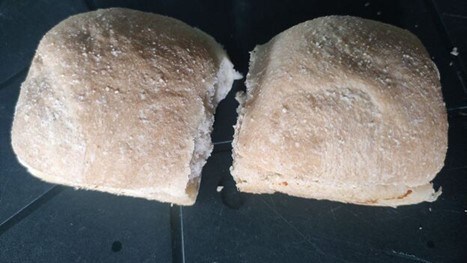Rice Husks Used in Cuba to Stretch Bread Dough

By Mercedes García (14ymedio)
HAVANA TIMES – “No one has eaten it in two days,” laments Luciano, a resident of the San Luis de Sancti Spíritus neighborhood, while showing some neighbors on Friday morning the rationed bread. In the midst of the wheat flour deficit, state bakeries in several areas of this city must add up to 20% of husked rice waste to the dough, a mixture that gives it a sandy texture and sour taste.
“They’re even using it in cakes, and they are hard, very hard,” adds the retiree, who, after shopping last Thursday at the standard bakery, returned to complain to the employee about the poor quality of the product. “We can’t do anything; we’ve been told to add up to 20% of rice straw and husks,” the worker explained. However, nowhere in the store is there a sign alerting customers to the new recipe.
“She told me because she has known me all her life, but they haven’t been told that they should inform consumers about this change,” says the retiree. The employee confessed to Luciano that “when they make the new formula, they have to increase the amount of rice, and it’s very difficult to mix in. The bakers are very upset with this, because they’re the ones who have to face the customers.”
Another worker at a bakery in the Viento Negro neighborhood confirms to 14ymedio the change in the manufacture of bread. He says that it began to be implemented this week, although it’s not the first time that other products have been added to the flour to stretch it. “They bring the bags of waste from the mills on the Jíbaro road, where the rice is husked,” he explains.
“It has usually been used as feed for pigs, because it includes rice straw and also the husks. As animal food it’s not bad, but it doesn’t help much to make bread.” The man says that “before this ’invention,’ the guajiros who raise pigs paid about 250 pesos for a can of this waste; they cooked it and then had something to give the animals to eat.”
However, in the mixture with wheat flour for human consumption, the state employee says that “the final dough dries out, and that’s why the bread crumbles as if it were sand. It also gets dark, and what doesn’t look good to the eyes doesn’t enter the mouth: people buy it and return it. As soon as they cut it, they see that dark, yellowish color and get scared.” On top of that, “it tastes bad, like a sack, like straw.”
Mixing other ingredients with wheat flour to make rationed bread is nothing new. In the crisis of the ’90s and also in recent months, state bakeries have used sweet potatoes, cassava and bananas to meet demand. But these mixtures haven’t managed to convince customers, who claim that with these additions the bread can be kept for less time due to the heat, and, to top it off, it quickly takes on a sour taste.
Translated by Regina Anavy for Translating Cuba
—–






Cuba has the capacity to be self sufficient in food. But central planning and price setting leaves little incentive for agricultural producers. At times the government is willing to pay more for imports than it pays for its own farmers. There is a need to address these problems if Cuba is to prosper.
And the questions should be. Why the Cuban people have to go trough all this sacrifice? What exactly the Cubans get through this and all the sacrifices of 63 years without freedoms, human rights and economic scarcity? What the people of Cuba can say to the rest of the world I’ve sacrificed my life but I have this and you don’t?